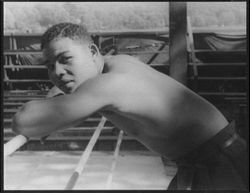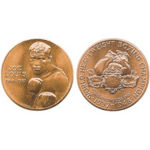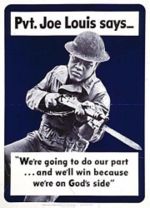Joe Louis
Joseph Louis Barrow (May 13, 1914 – April 13, 1981), known as Joe Louis and nicknamed "The Brown Bomber," was a highly successful professional boxer. In a single, unbroken championship reign of 11 years and 8 months, he defended his heavyweight title 25 times, both of which are world records. He is regarded as one of the greatest heavyweight boxers off all-time.[1][2] He also emerged as a cultural icon, particularly among blacks. He was embraced as a national hero in the United States, largely due to his defeat of the Nazi-sponsored Max Schmeling in a highly politicized and publicized 1938 fight.
Following Louis' death, President Ronald Reagan said, "Joe Louis was more than a sports legend -- his career was an indictment of racial bigotry and a source of pride and inspiration to millions of white and black people around the world."[3]
Louis was posthumously awarded the Congressional Gold Medal on August 26, 1982, which is the highest civilian award that can be issued by the United States Congress.[4]
Early Life
Joe Louis was born in Lafayette, Alabama (U.S. state) into a poor, sharecropping family with 8 children. When he was 2 years old, his father, the son of a former slave, was admitted to the Searcy Hospital for the Negro Insane. After being told that her husband had died, Louis' mother remarried another sharecropper named Patrick Brooks, who was also a widower and had 8 children.
In 1926, the family moved to Detroit, Michigan, where his stepfather and brothers worked on the assembly line at the local Ford Motor Company plant. With the arrival of the Great Depression in the 1930's, his father and brothers lost their jobs and the family fell on hard times. Louis started attending the Bronson Vocational School, where he was learning to make furniture.
Eventually, things began to settle down at home and at his mother's insistence, Louis began taking violin lessons. The violin made him the object of ridicule for his vocational school classmates, except for Thurston McKinney, who was a successful amateur boxer. McKinney invited Louis to come with him to Brewster's East Side Gymnasium. Eventually, McKinney invited Louis to spar with him. After being beaten around for a few rounds, Louis lost his temper and landed a right to McKinney's chin, nearly knocking him out. Thurston grinned and said, "Man, throw that violin away."[5] From that point forward, Louis dedicated his life to becoming a boxer.
Boxing Career
Amateur
Louis began to draw the attention of Brewster's owner Atler Ellis, who with the help of Holman Williams, began his formal training. His first amateur fight took place at the Naval Armory in Detroit, and was against a member of the 1932 Olympic boxing team, Johnny Miler. Louis was defeated in three rounds after being knocked down seven times. Louis was disheartened by his performance and temporarily gave up his training to work a regular job at the Ford factory. The work was hard and he realized quickly that he missed boxing. He reasoned that "if I'm going to hurt that much for twenty-five dollars a week, I might as well go back and try fighting again."[6]
Louis' second amateur fight was against Otis Thomas at the Forest Athletic Club. He knocked Thomas out in the first round. Louis would go on to defeat the next thirteen opponents he faced. His success led him to enter into the Golden Gloves and Amateur Athletic Union (AAU) tournaments. Louis would end up winning 50 of his 54 amateur fights, with 43 knockouts.
Professional
In 1934, Louis moved to Chicago, Illinois (U.S. state), where he was trained by Julian Black and John Roxborough] for his professional career. His first professional fight was on July 4, 1934 at the Bacon Casino against Jack Kracken. He knocked Kracken out with a left hook in less than 2 minutes. By the end of August, he was 5-0 with 4 knockouts. He would continue his dominance over the next 22 fights, until his first meeting with Max Schmeling on June 19, 1936.
Louis, being several years younger than Schmeling, was supposed to win the fight easily. But the former World Heavyweight Champion from Germany had been studying film of Louis' fights and found a weakness that he was able to take advantage of. Schmeling knocked Louis out in the twelfth round. Technically, this made Schmeling the number one contender to fight James Braddock for the championship, but some behind the scenes maneuvering by Louis' promoter Mike Jacobs gave Louis the title shot instead, which infuriated Schmeling. Louis went on to defeat Braddock by knockout to become the World Heavyweight Champion, a title he would hold for close to 12 years.
The stage was set for a rematch with Schmeling and this time the fight was sensationalized to seem all the more important. Adolf Hitler and the Nazi Party were causing concern in the rest of the world, as they steered Germany away from democracy and promoted racial hatred. Schmeling, although not being a Nazi, had become a favorite of Hitler and the propaganda surrounding the rematch, from both America and Germany, portrayed it as a great battle of the races. President Franklin D. Roosevelt told him, "Joe, we need muscles like your to beat Germany." This national pressure, on top of the fact that Louis craved revenge for his previous loss, was a strong motivator and led him to say to a friend before the fight, "I'm scared I might kill Schmeling tonight."[7] The fight lasted just over 2 minutes, with Louis quickly knocking Schmeling out and in doing so, propelling himself to the status of national hero.
Louis went on to actively defend his title, which deviated from the common practice of champions becoming notoriously inactive. He fought 21 title fights between 1937 and 1942, winning all but 3 by knockout. His opponents during this time frame earned the nickname of "The Bum of the Month Club".
Military
After the bombing of Pearl Harbor, Louis was scheduled to fight Buddy Baer at Madison Square Garden. In an unprecedented gesture, Louis decided to donate his winnings from the fight to the Naval Relief Society, a charity that supported families of sailors killed in action. On January 10, 1942, the night after the fight, Louis, in a patriotic gesture, volunteered for service in the United States Army.
At the time, the Army was still segregated and Louis was assigned to all black units. During his time at Fort Riley, Kansas, Louis became friends with Jackie Robinson, the man that would go on to break the color barrier in Major League Baseball. Robinson was an admirer of Louis, and found him not afraid to use his celebrity status to create opportunities for black troops. Louis used his connections in Washington to get Robinson and other blacks into officer candidate school.
Eventually, Louis was promoted to sergeant and the Army decided his value was not in fighting, but for providing a morale boost for the troops. He spent the rest of his time traveling across Europe and Africa putting on exhibition fights. Louis would retire from the military a month after the end of World War II.
End of career
Louis went on to an unprecedented 25 title defenses before retiring on March 1, 1949. A year later he came out of retirement to fight the new champion, Ezzard Charles, on September 27, 1950. The bout lasted the full 15 rounds, however Charles was awarded the victory by unanimous decision. Louis would go on to fight several more times, eventually retiring after an October 26, 1951 fight against Rocky Marciano in which he was knocked out. Louis finished his career with a record of 69-3, with 55 knockouts.
Later Life
Louis had managed to accumulate a large amount of debt during his career. From the beginning of his career in 1931 until the time he won the title in 1937, income tax rates had raised from 24 to 79 percent, and would eventually reach as high as 90 percent.[8]The high tax rate, coupled with Louis' generous spending habits - repaying his family's debts, donations to military charities - led him to owe over 1 million dollars in back taxes to the Internal Revenue Service by 1950. Many of his final bouts were fought in order to try and pay the government back. He would also turn to a short lived career as a professional wrestler, several television show and movie appearances, and finally working as a greeter at Caesars Palace in Las Vegas.
Louis developed a drug problem and in 1969 collapsed in Manhattan, brought on by his cocaine usage. A year later he was readmitted to a hospital because he was suffering paranoid delusions. His health would continue to deteriorate, and he suffered a series of several strokes and heart problems, leaving him confined to a wheelchair. He died of a heart attack on April 13, 1981 in Las Vegas, shortly after attending a fight between Larry Holmes and Trevor Berbick. At the request of President Ronald Reagan, he was buried at Arlington National Cemetery.
Notes
- ↑ International Boxing Research Organization All Time Rankings. Retrieved on 2007-08-01.
- ↑ ESPN's 50 Greatest Boxers of All Time. Retrieved on 2008-01-07.
- ↑ Statement By President Ronald Reagan on the Death of Former World Heavyweight Boxing Champion Joe Louis April 13, 1981. Retrieved on 2007-08-01.
- ↑ Office of the Clerk, U.S. House of Representatives list of Congressional Gold Medal recipients. Retrieved on 2007-08-02.
- ↑ Louis, p. 20
- ↑ Louis, p. 27 - At the time, amateur boxing could earn a boxer 25 dollars for a win and 7 dollars for a loss.
- ↑ Louis, p. 141
- ↑ Joe Louis vs. the IRS, by Dr. Burton W. Folsom of the Mackinac Center for Public Policy, July 7, 1997.. Retrieved on 2007-08-02.


